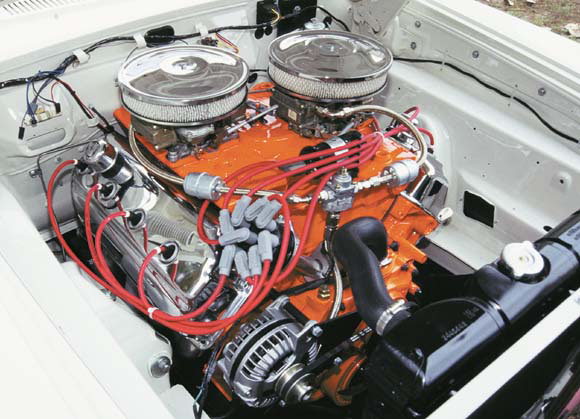 |
|
 |
|
| For the most part, muscle cars have lead rough lives. Face it, people didn’t pay the extra dollars charged by the factories for more horsepower simply to motor between the grocery store and the dry cleaners. No, when a factory hot rod was ordered — it was invariably run hard (if not by the owner then the owner’s children, sorry dad). And cars that see years of hard use tend to break parts. Parts like engines, transmissions and rear ends.
So now, some 25+ years later, there’s a very good chance the original drivetrain in your particular muscle car has been changed. But how would you confirm this? By checking the “numbers”, of course. You may have bought your car based on the promise by the previous owner that it was “numbers matching”. But unless you’ve checked them yourself, you really don’t know, do you? (Unless, of course, you’re the original owner — but how many of us can say that?) So the questions become: What is numbers matching, why is it important and how is it verified? In a nutshell, matching numbers refers to the various casting numbers, codes and dates found on all the major driveline components (engine, transmission, rear-axle assembly). On later models, the engine block and transmission carry the V.I.N. number as well as the part number and i.d. codes. But it doesn’t stop there. Each engine, for example, had a particular carburetor, distributor, set of cylinder heads, etc. for that combination. The true numbers matching car will also have the correct engine components as well. But unless you’re building a concours show car or paying six figures for a Hemi Cuda convertible, most enthusiasts aren’t overly concerned with carb and distributor numbers. The proper engine numbers are what most of us are concerned with. Why are matching numbers important? Well, unless you’ve paid a premium for a numbers matching car, or are planning on entering a concours show, they’re probably not. If you’re planning on simply driving and enjoying the car, it really doesn’t matter if the 440 is a ’69 or a ’70 model. But, given the price differences (and resale value) between a car with the original drivetrain and a car without, it pays to know how to tell the difference. But before we get into finding and decoding the numbers, we’ll give you a little Chrysler engine history. If you’ve got questions that aren’t addressed in this article, feel free to give us a call, we’ll help you any way we can. |
|
|
|
 |
|
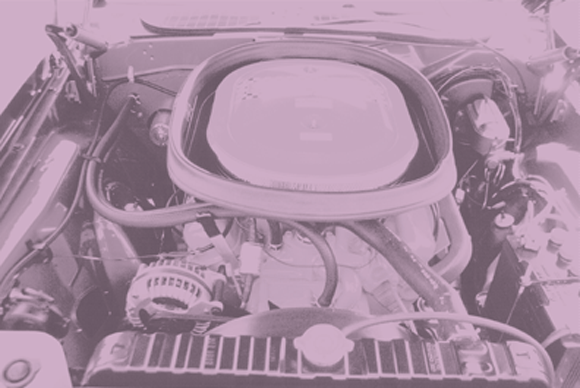 |
|
|
|
|
273 “LA” Engine
|
|
|
1964-69 • 3.63″ bore x 3.31″ stroke
Realizing the need for a lighter V8 engine for use in the smaller vehicles then coming on the scene, Chrysler designed its first “thinwall” small block. Known as the “LA” engine series, the first engine out of the box was the 273. Light and compact, the 273 posed much less of an engineering challenge to fit in the new A-body chassis. While never intended to be a powerhouse, high compression, solid-cammed 4-bbl versions of the 273 did run well in cars like the Barracuda Formula S.
|
|
|
318 “A” Engine
|
|
| 1957-66 • 3.91″ bore x 3.31″ stroke Filling the gap between the slant-6 and the early Hemi and later the “B” was the job of the 318 “A” engine. First produced in 1957, the first 318 employed “thickwall” casting techniques that, while very strong, handicapped it with excess weight. It did make decent power, was economical to operate and was reliable as a stone, making it perfect for its use as the base V8 engine.
|
|
|
318 “LA” Engine
|
|
|
1967-and-later • 3.91″ bore x 3.31″ stroke
Even though physically the 1967 318 “LA” V8 shared little more than bore and stroke dimensions with its “A” engine cousin, the two were identical with respect to their intended use. The “new” 318 was the base V8 powerplant for the entire Chrysler product line. Because of its lowly status, the 318 didn’t even receive a 4-bbl carburetor and manifold until 1978, when the 360′s setup was borrowed for use on the little workhorse. While the 318′s pedigree may not match that of the Hemi, the fact that with a few modifications it’s still in production some 30 years later speaks very highly of the engine’s capabilities.
|
|
|
340 “LA” Engine
|
|
|
1968-73 • 4.04″ bore x 3.31″ stroke
The 340 should be considered the “Hemi of the small block family”. Why? Simply because the 340 was designed from the outset as a performance engine. Look at the stats: high compression, big valves (2.02 intake, 1.60 exhaust), forged and shot-peened crank and rods, etc. These engines were built to perform well and stay together doing it. A testament to the 340′s power potential is the fact that Chrysler installed the beefy A-727 Torqueflite automatic behind it instead of the usual 904, the only small block to receive such an honor. 340 development peaked with the 1970 6-bbl version available only in the limited-edition AAR ‘Cuda and T/A Challenger (which were Dodge and Plymouth’s entries into the SCCA’s Trans-Am road racing series). Considerably underrated at 290 horsepower at 5000 rpm (not coincidentally, Chevy’s Z/28 302 and Ford’s Boss 302 were also rated at 290 horsepower), by turning it higher, which it was more than willing to do, resulted in much more power. The 6-bbl 340s had beefier blocks with thicker main webs to go along with the forged crank and rods. The cylinder heads were also unique to the 6-bbl engine. Chrysler relocated the intake pushrods, which allowed a much larger intake port opening and thus more flow. The valvetrain was adjustable, and induction chores were handled by three Holley 2-bbls on an aluminum intake manifold. In late 1972, with factory performance nearing an end, the 340 got a cast crankshaft and heads from the 360. But as far as small blocks go, the 340 is legendary.
|
|
|
360 “LA” Engine
|
|
|
1971-present • 4.00″ bore x 3.58″ stroke
Being the biggest of the small blocks doesn’t necessarily mean that it was the best performer. Though only equipped with a 2-bbl and a relatively low compression, the 360 was still able to turn out 255 horsepower (gross rating) in its first year of production. The following two years weren’t so kind to the 360 with horsepower levels falling to 175 and 170 respectively. Help did arrive in the form of a 4-bbl carb in 1974 though, and power rose to 245 net horsepower. Interestingly enough, the 360 is still in production, and the latest versions still generate 245 net horsepower. The beauty of the new engine is that through fuel injection and computer controls, this level of power is possible with good fuel mileage and low emissions. |
 |
|
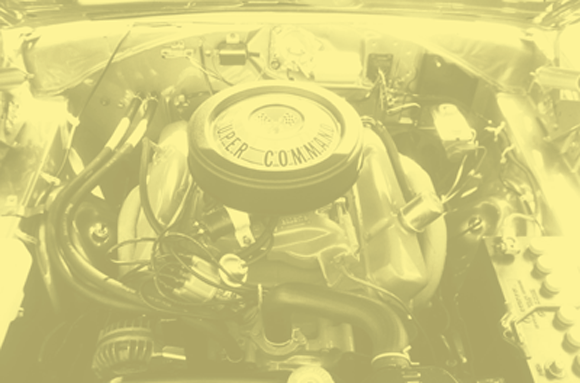 |
|
|
|
|
350 “B” Engine
|
|
|
1958 • 4.06″ bore x 3.38″ stroke
It may be hard to believe, but Chrysler built a 350 V8 some 9 years before the “Brand X” 350 arrived. The 1-year-only engine was considered a little brother to the 361. The Dodge Ram Fire version with single 4-bbl made 295 horsepower, while Plymouth’s Golden Commando made 305 hp using two Carter 4-bbls.
|
|
|
361 “B” Engine
|
|
| 1958-66 • 4.12″ bore x 3.38″ stroke Chrysler’s new-for-’58 “B” engine faced the unenviable task of replacing the early Hemi as the company’s biggest power producer. But, through solid engineering and modern (for the time) production techniques, the 361 proved up to the task. Although on the small end of the big-block scale, the 361 did pave the way for larger displacement engines in the years to come. Performance was good right out of the box, with a little-known electronically fuel-injected version making over 330 horsepower. While the later engines tend to grab most of the big-block glory, it all started with the 361.
|
|
|
383 “B” Engine
|
|
| 1959-71 • 4.25″ bore x 3.38″ stroke For 1959, Chrysler engineers opened the bore of the 361 up to 4.25″, a jump of almost 1/8″, and the 383 was born. Destined to become the workhorse big block, the 383 struck a fine balance between power, reliability and (relative) economy of operation — with an emphasis on power. A dual 4-bbl version released in 1963 was conservatively rated at 340 horsepower. By 1968, the single 4-bbl Super Commando 383 was rated (again conservatively) at 335 hp and was the standard engine in the new Road Runner, which became one of the most popular muscle cars ever built. Rarely the “star of the lineup”, the 383 was nevertheless the standard bearer of Chrysler’s big block family.
|
|
|
400 “B” Engine
|
|
| 1972-78 • 4.34″ bore x 3.38″ stroke The largest of the short-stroke “B” engines, the 400 was a late arrival on the big-block scene. Designed with an eye on the unleaded gas/low emissions future, the 400 was created by enlarging 383′s bore to 4.34″. Compression ratios were kept low on the 400 since the engine was engineered to replace the base 383 in non-performance applications. That’s not to say a 400 can’t be built to perform, however. The big-bore/short-stroke combination is a sure recipe for horsepower, if blessed with some compression and a decent set of heads, since the engine can be revved without encountering the high piston speeds faced by long-stroke engines. |
 |
|
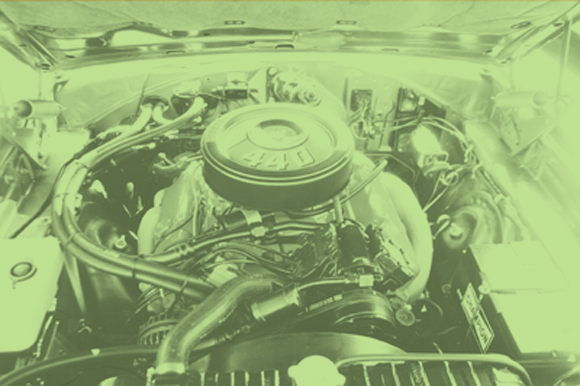 |
|
|
|
|
383 “RB” Engine
|
|
|
1959-60 • 4.03″ bore x 3.75″ stroke
This engine seems to be a greater point of confusion than any other engine. The 383 in this form is an “RB” engine (not the common 383 “B” engine). The 383 “RB” was only found in the Chrysler division car line from 1959-60 (in the Windsor and Saratoga models). Both a 2-bbl and 4-bbl existed with the 4-bbl making 325 hp. With only 2 years of production, these engines are quite rare today. |
|
|
413 “RB” Engine
|
|
|
1959-65 • 4.18″ bore x 3.75″ stroke
By raising the deck height of the B engine (hence the RB, or “Raised B” designation), Chrysler was able to increase the stroke on their big blocks to 3.75″, resulting in the 413 (when combined with a 4.18″ bore). Initially only available in Chrysler division cars, Dodge and Plymouth got it in 1961. In 1962 the 413 Max Wedge was introduced and in the capable hands of racers like Dick Landy, the 413 was breaking records all over the country. Through fine-tuning and careful modification, Super Stock racers of the day were making upwards of 450 rear-wheel horsepower with the Max Wedge.
|
|
|
426 “RB” Engine
|
|
|
1963-65 • 4.25″ bore x 3.75″ stroke
By 1963, both Ford and GM had 420+ cubic-inch engines on the streets and race tracks of America. Obviously Chrysler had to keep up, and did so by opening the 413′s bore to 4.25″, thus creating the 426 Max Wedge. In its initial form, the 426 was only slightly more powerful (rated at 425 horsepower) than the 413 it replaced. But with the release of the Stage III 426 Max Wedge in 1964, all comparisons to the 413 ended. The ’64 Max Wedge sported a lofty 13.0:1 compression ratio, a longer-duration cam, larger carbs and an elaborate equal-length “Tri-Y” exhaust manifold setup. The street 426 used a single 4-bbl, 10.5 compression ratio and a milder camshaft. While it obviously made less power than its Max Wedge brother, it was much more livable.
|
|
|
440 “RB” Engine
|
|
| 1966-78 • 4.32″ bore x 3.75″ stroke If there’s one golden rule of ’60s engine design, it’s simply bigger is better. Thus, the 440 cubic inch RB engine was born. Although debuting at a stout 365 horsepower in top form, the 440 was overshadowed by the Street Hemi which was released in the same year. But it didn’t take long for the 440 to make a name for itself. In 1969-70, the 440 reached its highest state of tune with the fabled 6-bbl version rated at 390 hp. This number declined slightly in 1971 to 385 hp, which was the last year for the 3×2-bbl option. The 440 remained in production until 1978, although by then it had been strangled by the same unleaded fuel and emissions monster that ultimately killed all of Detroit’s big blocks. But the fact remains that, at least on the street, the hot-rod 440 six bbl. engines of the ’69-70 period would often humble a similar Hemi-equipped model. |
 |
|
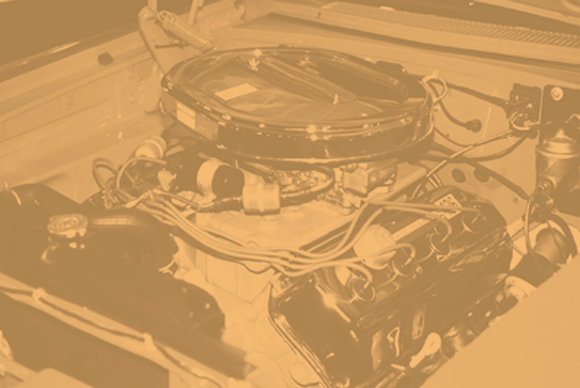 |
|
|
|
|
426 Hemi
|
|
|
1964-65 Race only, 1966-71 Street version • 4.25″ bore x 3.75″ stroke
How do you spell the ultimate in production performance engines? H-E-M-I. The mighty 426 Hemi was conceived in the early ’60s as the ultimate race engine, and ended up being the top powerplant of the muscle car era. But we’re getting ahead of ourselves. The story of the street Hemi actually starts in 1963, when Chevrolet set a new track record at Daytona with their Mark II “Mystery Motor”, the forerunner to the Mark IV big block. The Chevrolets broke during the race, which led to a Ford sweep in the biggest race of the year. Now, at Chrysler, the handwriting was on the wall. Get competitive or get out. So the Race Hemi was created by taking the early Hemi heads and adapting them for use on the RB bottom end. The mighty 426 race Hemi was ready for the ’64 race, where Chrysler finished 1-2-3. The engine was a stunning success — too much so in fact. Bill France, the Supreme Ruler of NASCAR, decreed that only production engines could be campaigned on his circuit. As a result, Chrysler boycotted the ’65 season but they would return. In 1966, the Street Hemi was born. With the engine now in production, the Hemi could be raced in NASCAR legally. The street version of the Hemi is surprisingly similar to the race-only version, with only minor changes made for civility. The compression ratio was lowered to a more livable 10.25:1. The radical cross ram manifold and lumpy cam didn’t make it either, but the street version did receive two 4-bbl carbs (mounted inline) and a solid-lifter cam big enough to churn out 425 horsepower (which was substantially underrated). The valvetrain was essentially the same as the race units, although the valve springs were replaced with much softer units to keep cam wear to a minimum. The factory developed a set of cast-iron exhaust manifolds to replace the racing headers, which reduced noise and increased durability. In street form the 426 Hemi became known as the top-dog muscle car powerplant until it disappeared after the 1971 model year (which, by the way, was also the last year for the 440 6-bbl). The Hemi did undergo a few running changes through its production life, with the most noticeable being the camshaft and block change in 1970. The mechanical cam was replaced with a hydraulic type, and the block was revised and strengthened also, basically making it suitable for use in fuel (nitro) drag racing. The rest, as they say, is history.
|
|
|






